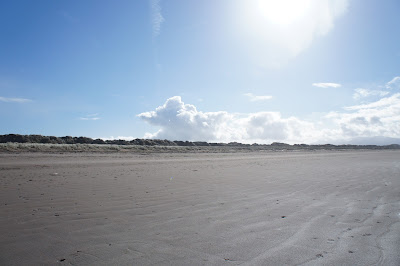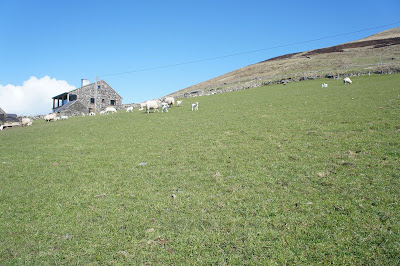Killarney Day 10: "Pizza for Rae... I mean Daisy."
Another day, another amazing selection of
experiences. I have learned and seen so much in the last few hours, and I am so
glad I get to share the beauty of the Dingle Peninsula. The history here goes
all the way back to the monks in the Beehive Huts and continues to evolve
today, thanks to sea marinas like the one in Dingle. Take a trip with me from
Killarney, to the beach at a place called Inch, to the edge of Slea Head and
the Blasket Islands—and maybe see the filming sight of Star Wars VIII along the
way…
Our final
journey in Killarney started at 9AM once again, this time headed for the Dingle
Peninsula. This is exactly on the other side of where we were yesterday—in
fact, we could often see the exact road we drove on from across the channel.
That was pretty cool to see! The mountains were bathed in sunshine and framed
by a cloudless sky as we sped down past the sparkling blue water.
After about a
half hour drive, we passed through onto the peninsula and landed at our first
stop: Inch Beach. Yes, there is a place called Inch, and they have a beautiful
beach there. As we all ran toward the ocean, we greeted an enthusiastic yellow
lab that we named Lucy. She stayed with us for our entire time at Inch,
enticing us to throw her a glove that she had found on the side of the road.
She bounded with us through the water, despite its chilly temperature. Many
people took their shoes off, but I did not want my feet to freeze and fall off
completely—even if they are still recovering from climbing Torc. Instead, I
contented myself with breathing the salt air and looking for Atlantic seashells
to add to my collection and give to friends back home. I found some amazing
mussel shells still intact, as well as a ton of clamshells and barnacles growing
on it. The morning sun created a haze over the whole beach that made it look
like a scene from a movie, or an oil painting in a museum. The mountains glowed
in the background, the sea blazed turquoise, the horizon line opened up in the
distance. It was truly amazing.
We slowly
removed the sand from our feet and shoes and headed back to the bus, then went
on our way to the Gealtacht region of the Dingle Peninsula. Here, Gaelic is the
first language; signs all read Gaelic first with English underneath, or no
English at all. Irish people speak English only to tourists who do not know
Gaelic. Even store names and advertisements (like the grocery stores we stopped
at in Dingle) had Gaelic phrases and no English. It is a storied region that
extends in pockets all the way up the West of Ireland, and we got to see a
small part of it.
But the real
reason for coming to this area was to see the ancient Beehive Huts in the town
on Fahan, used by monks in the early days of Irish Christianity. This
particular site is called Caher Conor, built on Mount Eagle just to the west of
Dingle town. Similar to the huts on Skellig Michael, these huts are made
completely through dry masonry—this means no mortar or nails, just stones
stacked in a corbeled style (curved inwardly) so that the capstones do not fall
in. This is what gives them their “beehive” shape. These huts are difficult to
date, but could be as old as 12th century examples of stunning dry
masonry. Even if we could not get out to see Skellig Michael, at least we could
stand atop Mount Eagle, with the huts beside us, and see the Skelligs out
across the way. It was humbling to see these huts in real life, and how
delicate they are. It is amazing that they have survived for so many years!
Also, as a quick
digression: I was the last one on the bus because I was trying to get pictures
of the huts without 32 people running all over them. Because of this, I was
subjected to sing a song over the bus’s microphone. Apparently this is a new
rule that I was unaware of. I chose “Row Row Row Your Boat” because we were
about to drive through the narrow pass on the way to the edge of the
peninsula—in case we fell in, at least we would be singing the right song.
We walked
through some of Slea Head so that the bus could maneuver more easily, and we
got to see some famine cottages along the road. These houses were built in the
19th century and housed the people most vulnerable to and hard-hit
by the potato famine. Because their diet only consisted of potato, these remote
farmers had nothing else to live on during the Great Hunger. Today, many of
them lay in ruin, but are protected from demolition by the Irish government as
heritage sites. People still live around these cottages, however. We passed by
many sheep and cow pastures, where we got to meet some adorable lambs and
calves before meeting the bus at the other end of the road. Lambs are
everywhere during this season, and I am so thankful to see their little bodies
bouncing around with excitement!
Back on the bus,
we made our way to the Blasket Island Centre, where we explored the museum. The
Blaskets are made up of 6 islands, with the largest housing the central
population for hundreds of years. The main occupation was fishing. There were
numerous stone houses, and the island even had a “king”. We watched a short
documentary film about how influential the Blasket Islands were to the study of
Gaelic by outsiders. The traditional language and lifestyle attracted many
English and European anthropologists and linguists, who helped to enlighten the
world. Because of this heightened interest, there are many autobiographical
books written by former residents of the island that I now want to read: The Island Man, Twenty Years A-Growing
and Peig, for starters. But the film
did not really explain why the people were removed from their island in 1953,
and why that was such a big deal to those inhabitants. Over the years, the
population of the island lowered to around 20 people. The school, once teaching
over 60 children, now had a class of four students. The government decided
there were not enough people left to populate the island, so they forcibly
removed them from their homes and resettled them on the Dingle Peninsula.
We
are going to learn more about the islands later, but for now, this was another
humbling introduction into the past lives of these historical Irish people. The
last man to be born on the Blaskets is now 69 years old—in one of the quotes from
the film, he said that “kids these days wouldn’t make it doing the things
necessary for survival on this island.” I think this is an incredibly important
message to the world in general to not take anything for granted. It might be
easy for us because of where we are from, but I personally feel that these
memories need to be shared so that we can understand just how lucky we are.
They also need to be remembered so that the Irish language can continue
thriving. I am looking forward to learning more about these islands and how
they fit into the history of Ireland as a whole.
On our way back
through the peninsula toward the Gallarus Oratory, we got to stop on the side
of the road to see where the cast of Star Wars is filming Episode VIII. We saw
a beehive hut in there, as well as a very tall sort of spire. Presumably, they
are doing filming on the mainland instead of Skellig (aka Luke’s hiding place),
which is impossible to get to this time of year, even without the film
equipment and actors on board. Instead, they just brought the hut to a cliff
looking out onto the ocean. We were too far away to see individual people, but
it was so cool to be a part of this amazing media masterpiece. I can’t wait for
the movie to come out so that we can see these shots!
Our geek session
over, we landed at the Gallarus Oratory hut. This is another example of dry
masonry, though this hut has a pointed top with capstones rather than a rounded
shape. Our professor explained that this shape was supposed to mimic an
upturned boat, since the “nave” of the church comes from the Latin word for
boat (navis). This particular site
was probably not used as a common church, but rather a pilgrimage site for
Christians traveling around Ireland. It only has one door and one window, each
fitted with stone hooks for door and window coverings. Though it is very small,
the acoustics are phenomenal. We tried and failed to sing a Gregorian chant,
settling on Sail by Styx. Because of the boat. Get it? Haha.
Anyway, our day
was almost over. Our final stop was Dingle town, where we got to eat lunch and
browse a little bit. We sat on the pier and ate the remains of our lunch, then
went straight to Murphy’s Ice Cream to get another two scoops of deliciousness.
This time, I got the caramel honeycomb and the cookie flavors. In hindsight, I
should have gotten the sea salt, but the cookie was very good. I would
recommend the honeycomb to anyone—light, refreshing, and just a little bit
sweet. We feasted on our ice cream whilst walking up the streets of Dingle,
past St. Mary’s Church, and into the Dingle Bookshop. We threatened to report
the percussionists of the band to the Dingle Percussion Workshop. All of the
buildings are brightly colored, advertising fish and chips or ice cream or
trinkets, and many hanging Irish flags. There were so many seafood stalls
featuring fresh caught fish from just out on the water. It was a typically
quaint seaside village, and I loved walking through it. After a final stop in
SuperValu for two more packages of Oaties (the best ones come from there, not
Tesco), we walked back toward the bus and the marina. I did not have time to walk
the marina itself, but I got a good glimpse of it from the parking lot below.
Apparently, this marina is one of the largest fisheries still running in
Ireland today. Pretty neat to see—and smell!
The long day was
finally done. We arrived back a the hotel around 5:15PM, just enough time to
relax a bit before dinner. Tomorrow is our last day in Killarney, and we plan
to leave at noon to go into town, do some shopping, and then explore the
grounds around Ross Castle once more before leaving for Galway on Saturday
morning. Our time here has been lovely, but I am ready to move on to the next
town. I have heard and learned so much about Galway, so I cannot wait to
finally see and hear it in person. But first, I’ll say goodbye to Killarney
with some more Murphy’s and some hiking. The perfect way to end the visit!
♥
photo credit Diana Cleveland & Katie Walker

































































































































No comments:
Post a Comment